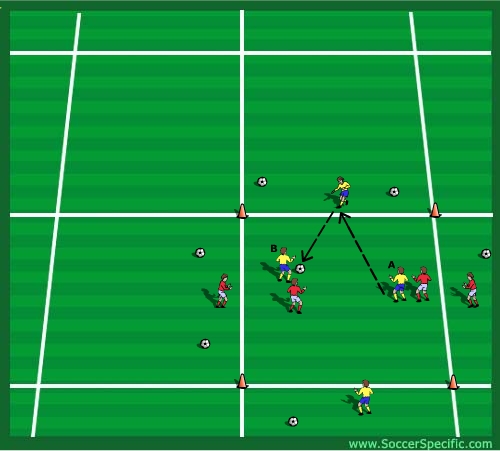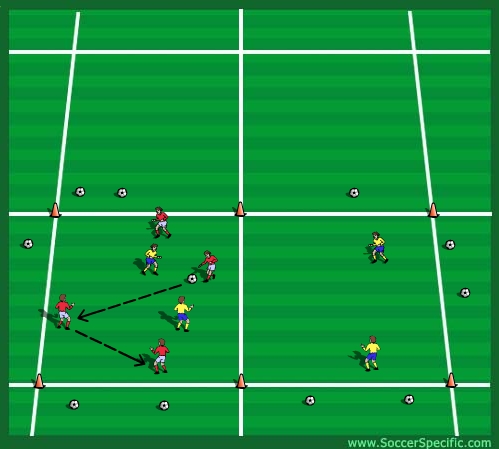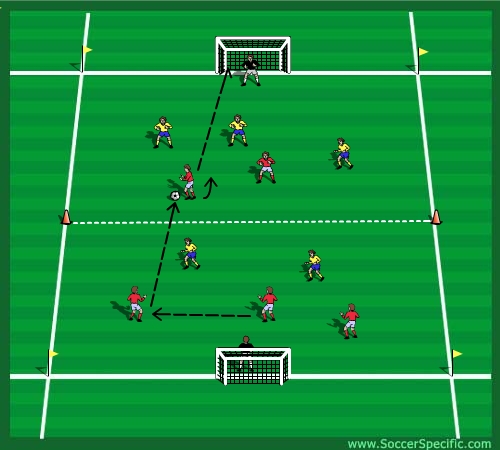Lang Wedemeyer is in his sixth season as head coach at South Dakota State University. In addition to starting the women’s soccer program at SDSU, Wedemeyer also has been involved in other aspects of the South Dakota and national soccer community. He is a National Soccer Coaches Association of America regional director, overseeing all the coaching certification in the Dakotas, Minnesota, Nebraska, Wyoming and Colorado. He has traveled throughout the state conducting coaching certification and running clinics over the past four years. One of the youngest coaches in the United States to obtain all levels of coaching certification, Wedemeyer holds nine professional soccer coaching licenses, including a United States Soccer Federation “A” license and the NSCAA Premier diploma.
Economical session that will combine technical, tactical, psychological and acyclic aerobic endurance.
Warm-Up:
Dynamic movement and flexibility exercises while moving freely an a half pitch as shown in Diagram (a) below.
These include:skips, side-shuffles, lunges (forward and side-ways), backward running, diagonal running (forward and backwards), cariocas, kicking at different heights, opening up and rotating the hips, etc. These, along with some light stretching with slow, coordinated movement, and increasing the heart-rate will be done over about 15 minutes at the beginning of training.

Activity #1:
Set Up:
2 reds vs. 2 yellows are positioned in the middle of a 12X12 grid as shown in Diagram (b) below. 2 yellows on outside of grid (North and South side).2 reds on outside (on East and West sides) as shown. Repeat setup to accommodate entire team.

Objective:
2v2 in the middle with “bumpers” on outside. “Bumpers” have 1-touch, players in the middle start with unlimited touches. Points are scored when Yellow (A) in the middle plays to Bumper who lays it off first time to Yellow (B) as shown above – or vice versa for Reds.
Play for 5-6 minutes per round and rotate players, this give each player about a 1:1 work to rest ratio. Do anywhere from 3-5 rotations – groups can be mixed as well. This works the continuous intensive conditioning.
Progressions:
- Unlimited touch
- 2 touch
- 1 touch by players in middle.
Coaching Points:
- Technique of holding ball under pressure.
- Passing with deception, weight of pass to partner or to bumper, accuracy of pass to bumper to be able to play first touch to partner to score point.
- Tactical: movement off ball, combining with partner and bumpers, timing and angles of support runs, etc.
- Psychological: staying focused in transition, dealing with speed of game and matching up 1v1.
- Fitness: short, intense movement repeatedly over the course of 5 minutes.
Activity #2
Set Up:
4v2 + 2. 4 Yellows and 4 Reds are positioned inside two 12×10 grids as shown in Diagram (c) below. A supply of balls is placed around the perimeter to keep the activity moving.

Objective:
4 reds keep possession of the ball (vs. 2 yellows) in a 12X10 grid. When the Yellows win the ball, they pass it to their 2 teammates waiting in attached grid. The 2 Yellows transition along with 2 Reds into the adjoining grid where 4 Yellows keep possession of the ball from the 2 Reds.
Progressions:
- Unlimited touch
- Mandatory 2 touch (teaches players to focus on what their first touch is doing for them)
- Maximum 2 touch then 1 touch.
Coaching Points:
- Technical: passing accuracy, passing in transition, angles of support, accuracy of first touch.
- Tactical: decision on number of touches and where first touch goes in relation to pressure, recognizing how to alleviate pressure to keep possession.
- Psychological: staying focused in transition, winning ball and keeping it.
- Fitness: mostly in transition moments = continuous intensive conditioning.
Note: There needs to be a coach or another player off to the side with extra balls to keep play continuous when balls go out of bounds.
Activity #3:
Set Up:
3v2 vs. 3v2 + Goalkeepers as shown in Diagram (d) below. Playing area is approximately 20×35 yards.

Objective:
3 Reds (+GK) play against 2 Yellows on one side of the grid with an adjoining grid of the same size with 3 Yellows (+GK) vs. 2 Reds.
3 Reds try to play to their 2 teammates in adjoining grid to score. If Yellow wins ball, they transition to teammates. Balls can be played back and forth between grids at any time, but (in beginning) no players can physically cross into another grid.
Progressions:
- Unlimited touch and no players can change grids
- Allow one player from back to come forward to create 3v3 in attacking zone.
- Minimize touches to increase speed of play.
- Take away restrictions to allow 5v5 free-flowing game.
Coaching Points:
- Technical: Passing under pressure, first touch that goes forward when possible to penetrate, laying balls off, shooting, holding ball under pressure.
- Tactical: Decisions on when and how to penetrate into attacking grid, how to support forward teammates, patience vs. speed in attack, how to utilize the GK, etc.
- Psychological: dealing with numbers up and numbers down, dealing with competition (create a reward for winning/scoring).
Fitness: In small area, by emphasizing high defensive pressure, this is still continuous intensive conditioning.
Notes: You can give extra points for forward players intercepting passes and scoring to increase incentive of working hard on defensive side of ball; you can make requirements that only the third player joining the two up front can score; once free play is established, use midline for off-sides; and you can require all players be across midline before team can score in 5v5.
In these different activities, players have the chance to get lots of repetitions on the ball both technically and be placed in small-sided tactical situations over and over. Decreasing/Increasing the size of the grid, number of touches and players can change the pressure in which players must technically play, tactically make decisions and physically have to deal with – both from a fitness standpoint as well as from a strength standpoint.
Since all of these activities are played at a high pace, it is important to give players rest time between reps/games.And most importantly, create competition in each activity
